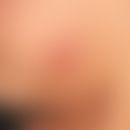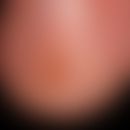Synonym(s)
DefinitionThis section has been translated automatically.
Harmless, transient, up to 0.2 cm large, single or disseminated epithelial cysts filled with whitish, horny beads, smooth on the surface, without open connection to the skin surface.
Occurrence/EpidemiologyThis section has been translated automatically.
The prevalence of newborn enzymes is about 15% (Monteagudo B et al. 2012).
You might also be interested in
EtiopathogenesisThis section has been translated automatically.
Transient dysfunction of the follicular apparatus leading to intraepidermal inclusion cysts in the follicular duct. Finally, the exact etiology is unknown.
LocalizationThis section has been translated automatically.
Transient eruptive milia of the infant are observed on forehead, cheeks and bridge of nose. Larger inclusion cysts may be found in the area of the prepuce and the scrotum.
Tansient white papules on the hard palate (Epstein pearls) and on the dental ridge (bean nodules) of newborns are considered the equivalent of milia.
ClinicThis section has been translated automatically.
The infant's milia are either already present at birth, or occur during the 1st year of life. They impress as 0.1-0.2 cm large, follicular, whitish, firm, asymptomatic papules (colloquially called skin gravel), which cannot be removed by simply "wiping over" them.
Spontaneous healing after a few weeks. The parents must be informed about the harmlessness of the findings.
As equivalents of the skin milia, transient whitish papules are found in the mucosal region of about 50-60% of the newborns in addition to milia of the skin in the median line of the hard palate (so-called Epstein's pearls) as well as on the dental ridge (so-called bean nodules).
Differential diagnosisThis section has been translated automatically.
Hyperplastic sebaceous glands of the infant: frequent phenomenon of the infant with centrofacial accentuation, white, non-inflammatory, follicular papules
Miliaria: smallest intracorneal vesicles
Neonatal cephalic pustulosis: eruptive follicular pustules on face, neck and capillitium
Eosinophilic pustulous folliculitis of childhood: mostly in older infants; rarely at birth. Recurrent occurrence of inflammatory follicular papules, distinct itching.
Progression/forecastThis section has been translated automatically.
Harmless; the milia of the newborn disappear without therapy and without leaving residuals after a few weeks.
Milia can be characteristics of rare syndromes:
LiteratureThis section has been translated automatically.
- Ekiz O et al (2013) Skin findings in newborns and their relationship with maternal factors: observational research. Ann Dermatol 25:1-4
- Monteagudo B et al (2012) Prevalence of milia and palatal and gingival cysts in Spanish newborns. Pediatric Dermatol 29:301-305
Incoming links (4)
Bazex-dupré-christol syndrome; Milia; Newborns, skin changes; Oro-fazio-digital syndrome type i;Outgoing links (7)
Bazex-dupré-christol syndrome; Eosinophilic pustular folliculitis; Miliaria; Neonatal cephalic pustulose; Oro-fazio-digital syndrome type i; Rombo syndrome; Sebaceous gland hyperplasia neonatal;Disclaimer
Please ask your physician for a reliable diagnosis. This website is only meant as a reference.





